Abstract
This study aims to examine the evolution of the literature related to human capital in the field of tourism, specifically addressing the gender dimension. It represents a novel approach to this field of study and promises to offer new perspectives and contribute to the debate on tourism management with equality of opportunity. To achieve this aim, a quantitative methodology was applied through a bibliometric analysis of 234 articles, published between 2020 and 2024, extracted from Web of Science and Scopus. Among the main results, a high level of collaboration and research on the topic, with a stable and growing trend, was observed. Influential journals include the Journal of Sustainable Tourism, Sustainability, and the International Journal of Contemporary Hospitality Management. Future research is suggested to focus on the impact of the female human capital on tourism management, as well as a qualitative analysis for a better understanding of the topic.
1. Introduction
Both the workforce and the bulk of the student body in the tourism sector is composed of a higher proportion of women than men, and this relationship is assumed to be inversely proportional at the top of the organizational pyramid (Burrell et al., 1997; Campos-Soria et al., 2011; Carvalho et al., 2019; Cave & Kilic, 2010; Carrasco-Santos et al., 2024; Jadnanansing et al., 2021; Jordan, 1997; Segovia-Pérez et al., 2019) However, a greater presence of women in formal tourism training (Iñiguez et al., 2013; Romo et al., 2024) could mean greater competitiveness skills (Chen & Wu, 2007) in tourism (Pritchard, 2014; Rodríguez Vera et al., 2024). For example, companies increase social responsibility standards as women occupy more and more management positions (Alonso-Almeida et al., 2015; Sánchez-Teba et al., 2021), which is a quality that could be extrapolated to the tourism sector.
Another relevant aspect in the formation of a concept associated with management in the tourism sector is that, in addition to being committed to the company’s success, the manager must possess specific management skills (Peráček & Kaššaj, 2023). These competencies are assumed to be acquired through studies in tourism, given the multidisciplinary nature of this field. Furthermore, considering the large number of women trained in tourism, it seems to fit within the concept of female human capital in management, where most of the imbalances between the number of women and men in leadership positions occur.
The application of bibliometric analysis in research in the field of tourism is already established. There are other bibliometric analyses applied to the area of tourism knowledge in general (e.g., Álvarez-García et al., 2018; de Oliveira et al., 2024; Lizano & Sánchez, 2020; Osorio-Andrade et al., 2023; Ortega et al., 2023; Quiroz-Fabra et al., 2023; Sánchez et al., 2019; Vieira Salazar et al., 2021), which are interconnected with the concept of gender as well; in fact, a bibliometric study confirmed the influence of gender in various areas, such as tourism management and human resources (Trillo-Rodriguez & Flores-Ruiz, 2023; Rodríguez Vera et al., 2024). This research shows the need to carry out future lines of research focused on human resources and tourism in order to to review whether there are differences between men and women in human resources, and if so, to investigate the factors that influence this, and whether it is reproduced in all activities or only in some (Trillo-Rodriguez & Flores-Ruiz, 2023). Likewise, there is a need to study the professional dynamics between men and women in the tourism sector (Vizcaino Suárez et al., 2016). This justifies the construction of a bibliometric study on gender, tourism and human capital.
This is a novel methodological approach for the subject of our study, which is human capital and competitiveness in the tourism sector from a gender perspective. As for the existing scientific production, although it is true that there are tourism studies with a gender perspective (Figueroa-Domecq et al., 2020a) on the human capital and efficiency binomial, they are scarce; therefore, our study yields new insights. In this regard, following the neoclassical theory of human capital performance, in the hospitality industry, the overeducation of women is penalized; moreover, having specific training does not contribute to increasing their salaries (Ons Cappa et al., 2020) The use of bibliometrics makes it possible to observe the evolution of a field of study in terms of its intellectual and social structure, among others (Koseoglu et al., 2016), as well as to understand the trend of studies in that area of knowledge (Quiroz-Fabra et al., 2023). In other words, the findings of this study are valuable for both academia and the business sector since, through a bibliometric analysis, the different phases of the development of this field of research are clearly revealed, as well as the new emerging lines of research (Sánchez-Teba et al., 2021). Therefore, the application of this tool was chosen to obtain a picture of the current scientific landscape of the three fields of study: human capital, tourism and gender, which could, in this way, provide answers to the research questions mentioned above.
In terms of practical implications, identifying the relationship between human capital, women, and tourism can provide an opportunity to design strategies in the sector that improve its productivity. It also makes it possible to lay the foundations for the conceptualization of “female human capital” and to construct a category of analysis (Vizcaino Suárez et al., 2016) to study its evolution over time, contributing to the debate on the path to be taken by management in the sector from the perspective of equal opportunities.
The main aim of this research is to analyze the current evolution of human capital in tourism from a gender perspective. To achieve this purpose, the following research questions are formulated:
Q1: What is the development of the literature on human capital and women in tourism in recent years?
Q2: Which journals are at the forefront in the publication of articles related to the research topic?
Q3: Which are the most influential published articles on the topic, considering its intellectual structure?
Q4: In relation to authorship, which countries and universities have the highest production of articles in this field of study?
Q5: What conceptual structure does tourism research present with respect to female human resources?
This research delves into the evolution of the literature on human capital in the field of tourism, paying attention especially to the gender perspective. Using a quantitative methodology based on a bibliometric analysis of 234 articles published between 2020 and 2024, it seeks to provide a comprehensive view of the current scientific landscape in this field. Data were collected from the Web of Science and Scopus databases. Key findings include a high level of collaboration among the researchers and a stable and growing trend in research on this topic. The most influential journals in this field are the Journal of Sustainable Tourism and the International Journal of Contemporary Hospitality Management.
This research not only contributes to the debate on equal opportunity tourism management but also aligns with the UN Sustainable Development Goal 5 on Gender Equality (Alarcón & Cole, 2019).
It is essential to highlight that, according to the ILO (International Labour Organization) definition, decent work means ensuring dignity, equality, a fair wage, and safe working conditions, with a particular focus on women. This model of work places people, especially women, at the center of development, promoting their empowerment and ensuring that they have the same rights as men to be protected from exploitation. Furthermore, it provides women with an inclusive and sustainable future, offering them equal opportunities in both the labor and social spheres (Robaj, 2020).
It highlights the need for future research that addresses the impact of female human capital in tourism management and uses a qualitative analysis for a deeper understanding of the topic.
2. Materials and Methods
The methodology of this study was based on a quantitative approach that involved a detailed analysis of the WOS and Scopus databases, using logical operators to select key terms related to female human capital in the tourism sector. The search was structured to ensure that the results were meaningful and reliable, addressing the three key aspects of the research: human capital, gender, and tourism.
After data collection, a synthesis process was carried out, consolidating information from both databases, removing duplicates, and consolidating relevant articles. This resulted in a total of 234 articles being selected for analysis. Regarding the description and refinement of the search, specific inclusion and exclusion criteria were applied, focusing on articles published since 2020 to study the current patterns. Additionally, the results were manually filtered to ensure that only articles directly related to the research topic were included. Finally, a comparison process was conducted between the results obtained from WOS and Scopus, analyzing trends in publication and the topics addressed regarding female human capital in tourism. This comparative analysis allowed for the identification of key patterns and gaps in the existing literature on the topic.
This study is based on a quantitative approach, utilizing high-prestige and high-quality databases such as WOS and Scopus to explore the presence of female human capital in the tourism sector. The selection of these databases was justified by their high standards in terms of the quality and prestige of scientific publications (Campina-López et al., 2024; Sánchez-Teba et al., 2021; Quispe Fernández et al., 2024). The data collection process was configured using logical operators to ensure meaningful and reliable results. Three key terms were used, linked by the logical operator “AND”: human capital, gender, and tourism. Additionally, to include related aspects and broaden the search, alternative terms were used, linked through the “OR” operator, such as “leadership education” or “human capital management”, in the human capital area. This methodology was applied in both WOS and Scopus, configuring the logical operators consistently across both databases (Figure 1).
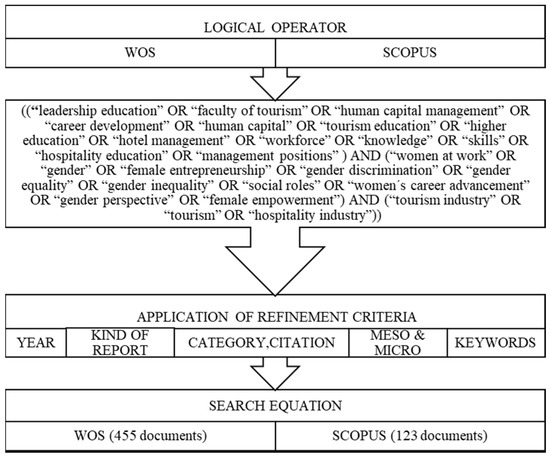
Figure 1.
Process in the elaboration of the search equation (source: own elaboration).
As for the refinement criteria, although it is normally proposed that the study should include publications from the last ten years, the choice of the time interval may vary depending on the bibliometric aspect to be investigated (Campina-López et al., 2024). For this case, and as already applied in other studies (e.g., Corrales-Reyes et al., 2018; Lizana Verdugo & Muñoz Cruz, 2022; Mercadal Cuesta, 2024), the most recent period since 2020 (4 and 5 years for WOS and Scopus, respectively) was chosen to analyze the current patterns. Likewise, a bibliometric study of tourism and gender covers a period ending in 2020 (Trillo-Rodriguez & Flores-Ruiz, 2023), thus complementing the previous (albeit more generic) research. Regarding the amount of the articles in the Scopus database, the range of years was extended because the search results yielded fewer results than those obtained in WOS, which was a limitation of the study. At the end of the process, a total of 455 articles were obtained from WOS and 123 from SCOPUS, for a total of 678 articles.
Prior to processing the data in R, a manual filter was performed, discarding articles unrelated to the subject of the study. Thus, articles such as “No harmless child labor: The effect of child labor on academic achievement in francophone Western and Central Africa” or “The Impact of Gender on the Link between Personality Traits and Entrepreneurial Intention: Implications for Sustainable Agriculture” were discarded. Subsequently, the research data were unified in R, eliminating a total of 44 repeated articles in both databases, resulting in a total of 234 articles. Finally, the database was loaded into biblioshiny, the interface of the Bibliometrix application, through which the bibliometric indicators shown below were obtained.
The study selection process, as illustrated in Figure 2, followed the PRISMA methodology to ensure a systematic and transparent review. Records were identified through searches in the WOS and Scopus databases, yielding a total of 678 studies. After removing 44 duplicate records, 634 studies were screened based on their titles and abstracts. During this phase, 2123 records were excluded for not meeting the inclusion criteria.
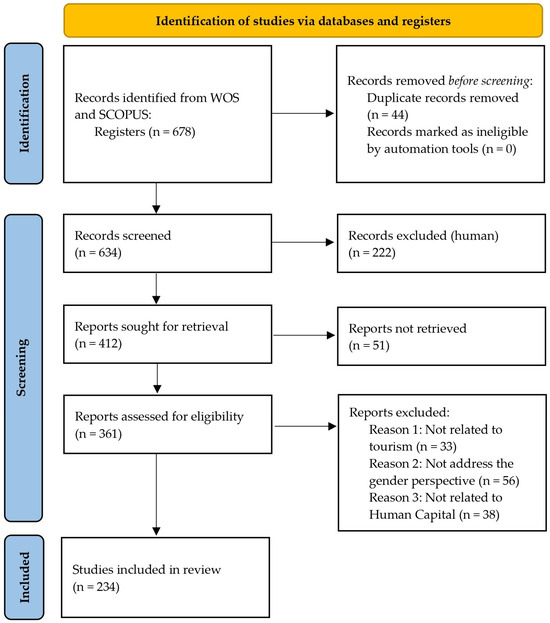
Figure 2.
PRISMA flow diagram (source: adapted from PRISMA 2020).
Subsequently, 412 studies were sought for retrieval, although 53 could not be accessed. The remaining 361 studies were assessed for eligibility through full-text reviews. Exclusions at this stage were categorized as follows: studies not related to tourism (n = 33), studies that did not address the gender perspective despite being tourism-related (n = 56), and studies unrelated to human capital (n = 38).
Ultimately, 234 studies met the eligibility criteria and were included in the review. This rigorous process, as outlined in Figure 2, ensures the reliability and relevance of the findings presented in the study.
3. Results
From the processing of the data, results were obtained that shed light on the research questions posed. With which, in a general description detailed in Table 1, it is specified that the sample contains 234 articles published from 2020 to 2024. In terms of content, 563 Plus keywords (ID) and 851 author keywords (ED) were used. Out of a total of 608 authors, 25 wrote their articles individually. The collaboration index was high, 2.99, and 96% of the articles was written under collaborative authorship (Martínez-Fierro & Lechuga Sancho, 2021).

Table 1.
Data overview (source: biblioshiny).
3.1. Annual Evolution of Documents
Figure 3 shows the distribution of the 234 articles indexed in the databases. There is a peak in the production of articles on gender, tourism and human capital in the year 2023, representing 28% over the total number of publications for the selected period, being the largest number in the sample, with 65 articles, and highlighting an increase in this period. Both the previous and subsequent years follow a similar trend in terms of publications indexed to WOS and Scopus. The trend is relatively stable, with a higher production in 2023.

Figure 3.
Annual scientific production on gender, human capital and tourism (source: biblioshiny).
3.2. Main Sources/Journals of Publication
One of the points to be addressed in a bibliometric analysis is the analysis of the main sources that publish research related to the fields of knowledge included in bibliometrics. In the case of the gender-tourism-human capital trinomial, the results of biblioshiny reveal that there is no specialized journal in the field of gender for human resources in tourism; this subject appears heterogeneously distributed in types of journals with a tendency towards management in the tourism sector. Of the total sample collected in the WOS and Scopus databases (234 articles), Journal of Sustainable Tourism accounted for 7% of the production, followed by Sustainability with 4.7%, and the International Journal of Contemporary Hospitality Management in third place, with a very similar percentage (4.2%). The fourth position is occupied by Tourism Management Perspectives with 3.4%, and the rest of the journals that appear as the most relevant account for less than 3% of the scientific production of the area of study. As for the sources that generate a greater impact, the Journal of Sustainable Tourism stands out.
The practical application of Bradford’s Law provides a mechanism to select journals that are not only the most productive, but also the most relevant in covering a particular field of knowledge (Urbizagástegui Alvarado, 2016). Based on these parameters and with the use of biblioshiny, a classification is obtained (Table 2), which includes the journals in zone 1 of Bradford’s core, i.e., those that are cited most frequently (Ardanuy, 2012). Therefore, the first three most relevant journals for “female human capital” in tourism are Journal of Sustainable Tourism, which is presented as the most cited journal with a frequency of 16 times from 2020 to 2024. This journal is followed by Sustainability, with a total of 11 citations for this period, and then, in third place, the International Journal of Contemporary Hospitality Management.

Table 2.
Classification of journals according to Bradford’s Law (source: biblioshiny).
To complete the information provided by Bradford’s Law, Figure 4 shows the dynamics of the production of the journals considered the most relevant in the field of study in these four years. The Journal of Sustainable Tourism begins the annual series without any publication with respect to the area of knowledge studied, but begins to experience exponential growth between 2021 and 2022, and continues to grow to become not only one of the most relevant journals, but also the one with the highest volume of production. While it is true that Sustainability is presented as a journal positioned in the highest position in terms of citation frequency, its trajectory in the production of articles on the subject, begins to stand out in 2022. The International Journal of Contemporary Hospitality Management and Tourism Management Perspectives present a stable and parallel evolution in the first year observed and, in 2022, they begin to separate their trajectory. International Journal of Contemporary Hospitality Management grows further to be the third most publishing journal in 2024. Tourism Management Perspectives shows a linear progress; the first year, 2020, shows an upward trend, but then it is quite constant in the number of publications. The highest production peaks for these journals occur in 2024, except for Tourism Management Perspectives, which reaches it in 2023.
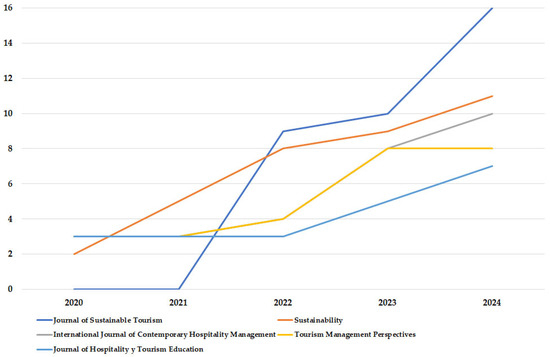
Figure 4.
Evolution of journal production (2020–2024) (source: biblioshiny).
3.3. Most Influential Articles
As shown in Table 3, the article with the highest number of citations, with a total of 56, highlights the existence of barriers for women leaders in their careers in the tourism sector and how a mentoring program can be a tool to overcome them (Dashper, 2020). Hutchings et al. (2020) represent the second most cited article, with a total of 55 citations since it was published in 2020, and through an introduction revealing the underrepresentation of women in tourism management positions despite accounting for the bulk of precarious work occupation. It also provides human resource management strategies (among others) to mitigate inequalities. In third place, in 2020, a qualitative analysis was published, addressing intersectionality through the influence of religion and legal norms on the career progression of women in Jordanian hospitality, with an average of 10 citations per year, and a total of 52 citations (Koburtay et al., 2020).

Table 3.
The 10 articles with the highest number of citations (source: biblioshiny).
In fourth position, Rinaldi and Salerno (2020) (with an average of nine citations per year) highlight both the vertical and horizontal gender segregation in the tourism sector even though women represent 46% of the workforce, with that number being even worse in emerging countries, presenting a case study in India. In the fifth position in the terms of the number of citations, Zhang and Zhang (2021) analyze how tourism impacts gender equality in emerging economies, and achieves a total of 30 citations from 2020 to 2024. The article by Je et al. (2020), the sixth article in the ranking, reaching 26 citations in the selected period, points out the need to create new standards to measure the practice of equality between men and women in the tourism business environment. In seventh place, with 25 citations in total, a study by Eger et al. (2021) highlights the need for a “future research agenda on gender and tourism sustainability”. Closing the ranking in the last three positions and with the same number of total citations (24) are the following articles: Rachmawati et al. (2022) concludes that gender has an impact on the work orientation–performance binomial in family tourism businesses; Gebbels et al. (2020) reflects on women’s career development in hospitality from a Western perspective; and Liu et al. (2020) seeks to investigate the career advancement of women in hospitality in China, considering factors such as expectations and family reconciliation.
3.4. Social Structure
In Figure 5, the ten most relevant out of the 608 authors are represented. Among them, with 10% of the total production, are E. Yang, A. Garcia-Pozo, K. Dashper; C. Khoo, and J. Mondéjar-Jiménez. The topics they investigate fit perfectly with the areas of study identified in the methodology.
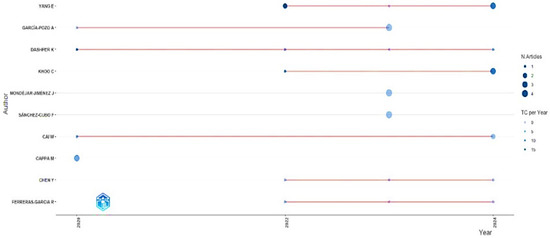
Figure 5.
Scientific production between 2020 and 2024 by author (source: biblioshiny).
The impact indicator of scientific production is determined by the intensity of the color of the circle—the greater the intensity the greater the impact; therefore, the highest number of citations corresponds to E. Yang, with 15 citations in the year 2022 and 10 in 2024, followed by K. Dashper with a total of 17.2 citations for the selected period, and by C. Khoo, whose work was cited 1 time in 2022 and 10 times in 2024.
On the other hand, as shown in Figure 6, Griffith University (Australia) stands out among the most prolific institutional affiliations at the global level. This university accounted for 15% of the scientific output between 2020 and 2024. The Griffith Institute for Tourism (GIFT) belongs to this university, with more than 130 academic members, adjuncts, and doctors from disciplines related to tourism, and within its specific research, there is a specific area of Human Resources in Tourism and Hospitality (Griffith Institute for Tourism, 2024). In second place, the Egyptian Knowledge Bank (EKB, hereinafter), an institution that represents 12% of the total number of publications in the study. In Spain, the Universidad Rey Juan Carlos stands out with 11% of the total production of the sample. This university has a Research Center for Tourism Studies with a team of 23 professionals, which also includes Human Capital and Tourism among its main lines of research Centro de Investigación de Estudios Turísticos de la Universidad Rey Juan Carlos. Among some publications closely linked to this bibliometric is Figueroa-Domecq et al. (2020b). Following this line, the University of Malaga also stands out with approximately 8% of the publications. It should be noted that this institution has the Institute for Tourism Intelligence and Innovation (I3T), whose research field deals with innovations for the management of human resources in tourism companies and destinations in international environments (Instituto de Inteligencia e Innovación Turística & Universidad de Málaga, 2024).

Figure 6.
Authors’ affiliations (source: biblioshiny).
Figure 7 and Figure 8 represent scientific activity worldwide. Thus, the countries with the highest production between 2020 and 2024 for these fields of study (human capital, tourism, and gender) are Spain, the United States (hereafter USA), Australia, China, and the United Kingdom. The scientific progression is not linear. Spain is at the forefront, presenting the highest number of publications (185) over the entire period and with exponential growth between 2023 and 2024, followed by the USA (92 publications, p. onwards) and Australia (78 p.), countries that alternate in second place, although Australia only overtakes the USA in 2022 (18 p. vs. 13 p. American) and the USA takes the lead again in 2023 (28 p. vs. 23 p. Australian). The same is true for China (74 p.) and the UK (68 p.), which occupy the lowest positions in the ranking. It is worth noting Spain’s distance from the rest of the countries.
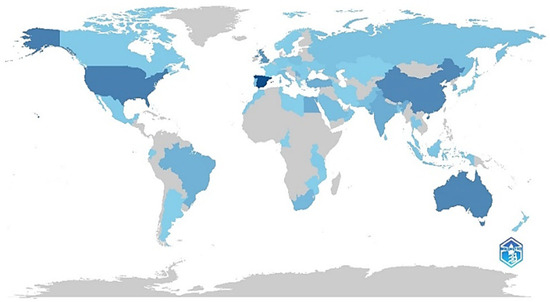
Figure 7.
Scientific production by country: 2020–2024 (source: biblioshiny). Note: The blue color indicates the quantitative importance of production.
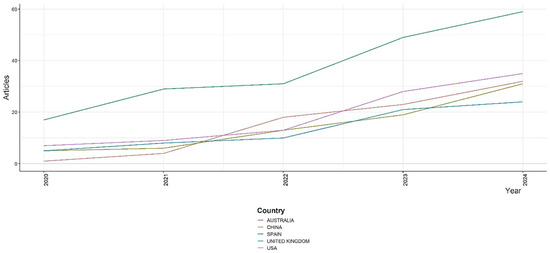
Figure 8.
Evolution of scientific production by country (source: biblioshiny).
3.5. Conceptual Structure
The following is the conceptual structure which, first shows the relationship between the keywords of the three areas of study (gender, human capital, and tourism), second, the network of co-occurrence of these terms, and lastly, the thematic map of the topic studied, as well as a representation of its evolution. These data reveal the scientific interest in the topic and which concepts are the most studied (de Oliveira et al., 2024).
3.5.1. Frequent Keywords and Trending Topics
Figure 9 below shows the keywords most frequently used in the literature on human capital, tourism, and gender. Thus, the size of the word determines the frequency with which the terms are used, with gender (above all), tourism, labor, management, women, impact, education, hospitality and knowledge standing out. The rest of the terms have a close similarity or are part of those previously mentioned among them: female, tourism development, employment, strategies, gap, gender differences, skills, and student body.

Figure 9.
Cloud of most frequently recurring words (source: biblioshiny).
Figure 10 shows the trend of the top 10 keywords in terms of frequency of use for the selected study period (2020–2024). It can be observed that in 2020, there was a minimal difference in use among all the terms, but from 2021 onwards the use of gender as a keyword begins a fairly pronounced upward trend that continues to increase until 2024, considerably disassociating itself from the rest.
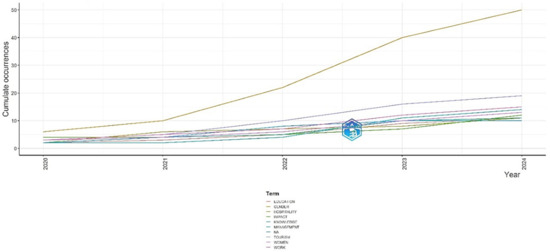
Figure 10.
Usage trend of the main keywords 2020–2024 (source: biblioshiny).
3.5.2. Co-Occurrence Network
The co-occurrence network presented in Figure 11 shows the presence of seven interconnected clusters governed mainly by the terms gender, work, tourism, sustainability, corporate social responsibility (CSR) and competition. On the one hand, and in purple, the concept of gender is represented, which is densely linked to knowledge, management, self-efficacy, perceptions, business, decision making, antecedents and consequences. In blue, there is another set linked to the concept of work and alluding to the following terms: women, strategies, gender differences, diversity, discrimination, job satisfaction, gap, industry, and experiences. As for the concept of tourism, it seems that two distinct clusters appear: on the one hand, there is the set represented by orange, which includes terms such as education, behavior, employment, skills, etc., and separately there is the red group, which includes concepts such as sustainability, ecotourism, tourism development, and Spain. Finally, the sets with the lowest number of terms are green and brown, which encompass the words satisfaction, competence, company performance, and CSR.
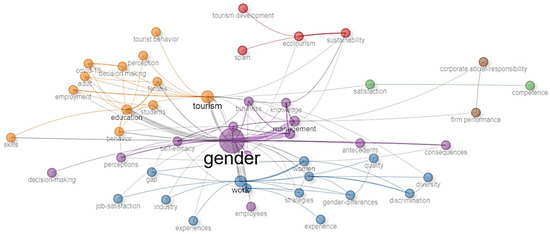
Figure 11.
Co-occurrence network (source: biblioshiny).
3.5.3. Thematic Map
Figure 12 is divided into quadrants. In the upper right quadrant, the driving themes—tourism, education, and the student body—are positioned, indicating that they are well developed. These themes can be considered as key drivers in relation to human capital, the tourism sector, and gender.
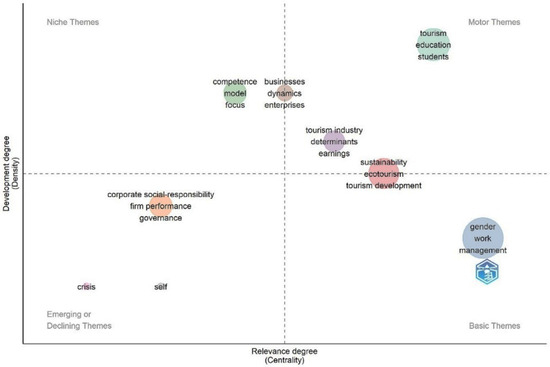
Figure 12.
Thematic map (source: biblioshiny).
The lower right quadrant is where the cross-cutting themes are located; in this case, these include gender, labor, and management. Their placement in this quadrant indicates that, while they are relevant and interconnected, they are still underdeveloped. These topics appear to serve as a bridge between the main research themes of this analysis, suggesting that they are emerging areas that require further exploration and development to fully integrate into the broader discourse on human capital, tourism, and gender.
In the upper left quadrant, the marginal, very specialized topics are presented. In other words, these are developed topics, but they are not highly relevant to the scientific development of this field of knowledge. These topics correspond to competence, model, and focus.
In the lower left quadrant, emerging or disappearing topics are grouped together. This position, revealed through bibliometric analysis, suggests that the topic of crisis may be on the verge of disappearing from this area of research, while others, such as governance or CSR (Corporate Social Responsibility), may emerge as more relevant areas for future exploration.
4. Discussion and Conclusions
The following answers (A, hereafter) to the questions previously raised in the present research are presented:
A1—A high level of collaboration in the development of the scientific literature on human capital, tourism, and women is observed. Productivity reached its peak in 2023, maintaining this level until 2024, following a similar result in 2022. The trend over the past four years remains stable, indicating sustained interest in gender in tourism, with an upward trend continuing since 2020 (Trillo-Rodriguez & Flores-Ruiz, 2023). This is understood as the existence of a network, as this collaboration denotes the creation of a network around this concept. This network generates synergies that drive the creation of new articles and justify their production.
A2—The main journals in the field of “female human capital” in tourism are Journal of Sustainable Tourism (United Kingdom, SJR Q1), Sustainability (Switzerland, SJR Q2), and International Journal of Contemporary Hospitality Management (United States, SJR Q1) (SCIMAGO, 2024). Journal of Sustainable Tourism experienced a decline in 2020 but resumed and expanded its publications starting in 2021. Similarly, International Journal of Contemporary Hospitality Management has gained prominence since 2020 (Trillo-Rodriguez & Flores-Ruiz, 2023). This denotes that the production meets certain quality standards, indicating that the topic addressed is of interest within the scientific community.
A3—The intellectual structure of the human capital–tourism–women trinomial, influencing the area of knowledge in general, is based on the following articles: Dashper (2020) highlights the barriers women must overcome in the development of their professional careers in tourism, proposing mentoring as a solution; Hutchings et al. (2020) address the lack of female representation at the top of the organizational pyramid (Burrell et al., 1997; Campos-Soria et al., 2011; Carvalho et al., 2019; Cave & Kilic, 2010; Carrasco-Santos et al., 2024; Jadnanansing et al., 2021; Jordan, 1997; Segovia-Pérez et al., 2019). This issue remains relevant, as a clear underrepresentation of female leaders continues to exist, which is corroborated by other key articles. Rinaldi and Salerno (2020) emphasize both vertical and horizontal barriers in the sector. Other topics addressed in the intellectual structure of female tourism human capital that influence the scientific landscape include intersectionality, gender inequalities in emerging economies, and the creation of protocols and medium- and long-term measures to reduce them. Additionally, among these articles, the incidence of job performance based on gender is discussed.
Some of the barriers identified in the literature, including Dashper’s study in 2020, Mentoring for gender equality: Supporting female leaders in the hospitality industry, highlight the lack of female role models in leadership positions, as well as the prevalence of imposter syndrome among women in the hospitality sector. In her widely cited research, a mentor points out that many women do not apply for leadership positions unless they feel they meet 110% of the requirements, in contrast to their male colleagues, who tend to trust that they will acquire the necessary skills while performing the role. The following section demonstrates Dashper’s relevance through a bibliometric analysis that highlights the high number of citations her work has received.
Moreover, organizations continue to operate under masculine norms that define the standard of the “ideal worker”, making it difficult to include diverse leadership models. Added to this are barriers related to motherhood and the care of dependents, responsibilities that, in most cases, still fall on women. These dynamics not only limit their professional development but also reinforce organizational structures that penalize those who cannot adhere to the traditional model of full availability (Dashper, 2020).
A4—Spain is the leading country in studies on this subject with the highest production, but it is not with the highest number of affiliations; in fact, Griffith University in Australia is the one that stands out, in addition to having a specific area of human resources in tourism and hospitality Griffith Institute for Tourism (2024). Likewise, Spain is positioned among the top positions through the Rey Juan Carlos University, which presents a specific line of research called Human Capital and Tourism, and through the University of Malaga, which does not appear among the top positions before 2020 in another bibliometric study on gender and tourism by Trillo-Rodriguez and Flores-Ruiz (2023). This last Spanish university addresses research linked to innovation in tourism human resources.
Considering that other countries, such as France and Italy, are strong competitors of Spain in the tourism market, it is not surprising that Spain excels in this type of research, as it is a country that, within Europe, is at the forefront in matters of equality. Since 1983, efforts have been underway to reduce inequalities between men and women through public policies (Instituto de la Mujer, 2024).
In relation to authorship, Yang, García, Dashper and Khoo stand out with the highest number of citations. The most cited articles address issues such as the wage gap, the digital divide, how tourism affects women’s emancipation, and how to get women into tourism organizational leadership. It should be noted that they do not limit themselves to making empirical contributions but rather seek ways to correct inequality, fitting into the gear of female human capital in the tourism sector.
Tourism contributes a significant percentage to Spain’s GDP, which makes human resource management key to achieving efficiency. Therefore, it is relevant that there is scientific production and support for research, highlighting, in other cases, the barriers described as negative externalities to be corrected in order to achieve organizational efficiency.
A5—The conceptual structure on which one could begin to build the concept of female tourism human capital includes terms such as tourism, work, management, women, impact, education, hospitality and knowledge. The interconnections formed by the main keywords are governed by six axes: gender, work, tourism, sustainability, CSR, and competence. The themes that drive the direction of research in this field are tourism, education and the student body, topics closely linked to the configuration of human capital in any sector. Gender, labor, and management are presented as cross-cutting themes that show little development in the area, which, a priori, would justify the need for greater research production. Other themes that may emerge are governance, which is currently much discussed.
Additionally, this conceptualization, which will enable the creation of a unit of analysis (Vizcaino Suárez et al., 2016) and serve as the rationale for its development, includes the general characteristics of human capital, as outlined in this bibliometric analysis. Therefore, it comprises attributes related to management, education, and specific competencies, under the framework of sustainability and corporate social responsibility, with the goal of contributing to the governance of destinations. This latter topic is emerging within this scientific field.
The main research directions in this area are tourism, education, and the student body, topics closely linked to the configuration of human capital in any sector. Gender, labor, and management appear as cross-cutting themes with limited development in the field, which, a priori, would justify the need for increased research production. Other topics that may gain relevance include governance, a subject of extensive discussion today.
Social responsibility is closely linked to improving efficiency in this aspect within companies led by women, as proposed by Alonso-Almeida et al. (2015) and Sánchez-Teba et al. (2021).
As a result, we can outline a conceptualization of female human capital characterized by its underutilization. One of the main indicators of this human capital is precisely its lack of utilization, caused by the barriers that prevent women trained in tourism from accessing managerial positions. It is worth questioning whether human capital can be defined as female or male, perhaps finding it more appropriate to categorize it under the umbrella of underutilized tourism human capital. The reason why it is important to highlight the term “female” lies in the fact that this underutilization is directly linked to the inequalities between men and women, inequalities that become more apparent and illogical in highly feminized sectors with a larger proportion of qualified labor, as is the case in tourism
Recapping, underutilized female human capital in tourism is defined as the set of skills and knowledge acquired by women through their academic training, combined with the personal and professional competencies developed in the tourism sector. This potential is underused due to structural barriers that hinder their access to managerial positions, thereby limiting the ability to improve key areas such as governance and social responsibility within the tourism industry.
Given the high percentage of female labor in the tourism industry, it is essential to analyze this concept from a gender perspective, as well as the structure that enables the creation of effective laws and policies to strengthen women’s rights in the sector.
To recap, these findings support the need for further studies and continued research in this area.
Scientific value: This study identifies influential journals such as the Journal of Sustainable Tourism and the International Journal of Contemporary Hospitality Management, which play a crucial role in the dissemination of knowledge in this field. Furthermore, Spain leads in scientific production, with prominent universities addressing innovation in human resources and tourism, while international institutions like Griffith University also contribute significantly. These findings position the topic within the most relevant scientific debates.
Practical value: From a practical perspective, the results highlight the importance of creating laws and policies that promote gender equality in the tourism sector. Practical solutions, such as mentorship programs and long-term measures, offer valuable tools to overcome structural barriers within the sector. Moreover, the identification of emerging topics such as governance and corporate social responsibility underscores the need for future research to address these issues from a sustainable approach.
5. Limitations and Future Research
This study, as mentioned earlier, contributes to advancing the conceptualization of female human capital in the tourism sector. However, as a bibliometric analysis it has certain limitations. One of the possible biases of this bibliometric analysis lies in the databases used. As mentioned in the methodology, in the case of the Scopus database, it was necessary to extend the range of years because the initial search yielded fewer results compared to Web of Science (WOS), which represented a limitation of the study. At the end of the process, a total of 455 articles were collected from WOS and 123 from Scopus, resulting in a total of 678 articles.
This study shows the direction towards the conceptualization of the concept, but it would be beneficial to refine it with greater precision through a systematic review of the literature, which would enable a more comprehensive understanding. Consequently, this limitation also represents a potential avenue for future research.
Furthermore, it would be interesting to explore in the future other concepts related to human capital in which women are involved, using a similar methodological approach. Some of the future research lines proposed include the study of underutilized tourism human capital and its impact on the governance of the tourism sector. In this regard, it is suggested to analyze the actual presence of women in governance as a key factor for success, optimizing specific human capital within the tourism sector.
The analysis conducted demonstrates that governance, within this context, is an emerging topic that represents a significant novelty in relation to the subject matter.
Author Contributions
Conceptualization, R.S.-R., J.R.R.S., M.D.S.-F. and J.R.-C.; methodology, R.S.-R., J.R.R.S. and M.D.S.-F.; formal analysis, R.S.-R.; investigation, R.S.-R.; writing-original draft preparation, R.S.-R.; writing-review and editing, J.R.R.S., M.D.S.-F. and J.R.-C.; supervision, J.R.R.S. and M.D.S.-F. All authors have read and agreed to the published version of the manuscript.
Funding
This research received no external funding.
Institutional Review Board Statement
Not applicable.
Informed Consent Statement
Not applicable.
Data Availability Statement
The data presented in this study are not publicly available due to privacy and ethical restrictions.
Conflicts of Interest
The authors declare no conflicts of interest.
References
- Alarcón, D. M., & Cole, S. (2019). No sustainability for tourism without gender equality. Journal of Sustainable Tourism, 27(7), 903–919. [Google Scholar] [CrossRef]
- Alonso-Almeida, M. d. M., Fernández de Navarrete, F. C., & Rodriguez-Pomeda, J. (2015). Corporate social responsibility perception in business students as future managers: A multifactorial analysis. Business Ethics: A European Review, 24, 1–17. [Google Scholar] [CrossRef]
- Ardanuy, J. (2012). Breve introducción a la bibliometría. Universitat de Barcelona. Available online: http://hdl.handle.net/2445/30962 (accessed on 20 April 2024).
- Álvarez-García, J., Maldonado-Erazo, C., del Río-Rama, M. C., & Sánchez-Fernández, M. D. (2018). Analysis of the studies regarding the impacts of creative tourism indexed in the Scopus and WoS base. Revista Portuguesa de Estudos Regionais, 48, 17–32. [Google Scholar]
- Burrell, J., Manfredi, S., Rollin, H., Price, L., & Stead, L. (1997). Equal opportunities for women employees in the hospitality industry: A comparison between France, Italy, Spain and the UK. International Journal of Hospitality Management, 16(2), 161–179. [Google Scholar] [CrossRef]
- Campina-López, A., Lorca-Marín, A. A., & de las Heras Pérez, M. A. (2024). Indagación, modelización y pensamiento computacional: Un análisis bibliométrico con el uso de Bibliometrix a través de Biblioshiny. Revista Eureka sobre Enseñanza y Divulgación de las Ciencias, 21(1), e1102. [Google Scholar] [CrossRef]
- Campos-Soria, J. A., Marchante-Mera, A., & Ropero-García, M. A. (2011). Patterns of occupational segregation by gender in the hospitality industry. International Journal of Hospitality Management, 30(1), 91–102. [Google Scholar] [CrossRef]
- Carrasco-Santos, M. J., Seyfi, S., Hosseini, S., Hall, C. M., Mohajer, B., Almeida-García, F., & Cortes Macías, R. (2024). Breaking boundaries: Exploring gendered challenges and advancing equality for Iranian women careers in tourism. Tourism Management, 103, 104913. [Google Scholar] [CrossRef]
- Carvalho, I., Costa, C., Lykke, N., & Torres, A. (2019). Beyond the glass ceiling: Gendering tourism management. Annals of Tourism Research, 75, 79–91. [Google Scholar] [CrossRef]
- Cave, P., & Kilic, S. (2010). The role of women in tourism employment with special reference to Antalya, Turkey. Journal of Hospitality Marketing & Management, 19(3), 280–292. [Google Scholar] [CrossRef]
- Chen, Z., & Wu, Y. (2007). The relationship between education and employment: A theoretical analysis and empirical test. Frontiers of Economics in China, 2, 187–211. [Google Scholar] [CrossRef]
- Corrales-Reyes, I. E., Acosta-Batista, C., Reyes-Pérez, J. J., & Fornaris-Cedeño, Y. (2018). Análisis bibliométrico de MEDICC review. Período 2010–2015. Educación Médica, 19, 325–334. [Google Scholar] [CrossRef]
- Dashper, K. (2020). Mentoring for gender equality: Supporting female leaders in the hospitality industry. International Journal of Hospitality Management, 88, e102397. [Google Scholar] [CrossRef]
- de Oliveira, M. S., Soares, J. R. R., & Solla, X. (2024). Avaliação de Políticas Públicas de Turismo. Revista Turismo y Desenvolvimento, 45, 85–105. [Google Scholar] [CrossRef]
- Eger, C., Munar, A. M., & Hsu, C. (2021). Gender and tourism sustainability. Journal of Sustainable Tourism, 30(7), 1459–1475. [Google Scholar] [CrossRef]
- Figueroa-Domecq, C., de Jong, A., & Williams, A. M. (2020a). Gender, tourism and entrepreneurship: A critical review. Annals of Tourism Research, 84, 102980. [Google Scholar] [CrossRef]
- Figueroa-Domecq, C., Kimbu, A., de Jong, A., & Williams, A. M. (2020b). Sustainability through the tourism entrepreneurship journey: A gender perspective. Journal of Sustainable Tourism, 30(7), 1562–1585. [Google Scholar] [CrossRef]
- Gebbels, M., Gao, X., & Cai, W. (2020). Let’s not just “talk” about it: Reflections on women’s career development in hospitality. International Journal of Contemporary Hospitality Management, 32(11), 3623–3643. [Google Scholar] [CrossRef]
- Griffith Institute for Tourism. (2024). Available online: https://www.griffith.edu.au/institute-tourism (accessed on 2 March 2024).
- Hutchings, K., Moyle, C.-L., Chai, A., Garofano, N., & Moore, S. (2020). Segregation of women in tourism employment in the APEC region. Tourism Management Perspectives, 34, e100655. [Google Scholar] [CrossRef]
- Instituto de Inteligencia e Innovación Turística, & Universidad de Málaga. (2024). Available online: https://www.uma.es/institutos-uma/info/117679/instituto-de-inteligencia-e-innovacion-turistica/ (accessed on 2 March 2024).
- Instituto de la Mujer. (2024). 40 años de políticas públicas de igualdad en España. Available online: https://www.inmujeres.gob.es/publicacioneselectronicas/documentacion/Documentos/DE2094.pdf (accessed on 2 April 2024).
- Iñiguez, T., Plumed, M., & Latorre, M. P. (2013). Tourism education and research in Spain from a gender perspective. Rotur: Revista de Ocio y Turismo, 6, 51–65. Available online: http://hdl.handle.net/2183/12641 (accessed on 20 April 2024).
- Jadnanansing, M., Nierop, T., & DiPietro, R. B. (2021). Women in hospitality leadership: Barriers and best practices in Aruba. Journal of Human Resources in Hospitality & Tourism, 20(2), 174–197. [Google Scholar] [CrossRef]
- Je, J. S., Khoo, C., & Yang, E. C. L. (2020). Gender issues in tourism organisations: Insights from a two-phased pragmatic systematic literature review. Journal of Sustainable Tourism, 30(7), 1658–1681. [Google Scholar] [CrossRef]
- Jordan, F. (1997). An occupational hazard? Sex segregation in tourism employment. Tourism Management, 18(8), 525–534. [Google Scholar] [CrossRef]
- Koburtay, T., Syed, J., & Haloub, R. (2020). Implications of religion, culture, and legislation for gender equality at work: Qualitative insights from Jordan. Journal of Business Ethics, 164(3), 421–436. [Google Scholar] [CrossRef]
- Koseoglu, M. A., Rahimi, R., Okumus, F., & Liu, J. (2016). Bibliometric studies in tourism. Annals of Tourism Research, 61, 180–198. [Google Scholar] [CrossRef]
- Liu, T., Shen, H., & Gao, J. (2020). Women’s career advancement in hotels: The mediating role of organizational commitment. International Journal of Contemporary Hospitality Management, 32(8), 2543–2561. [Google Scholar] [CrossRef]
- Lizana Verdugo, A. A., & Muñoz Cruz, M. R. (2022). Análisis bibliométrico sobre la práctica reflexiva en la formación de profesores. Estudios Pedagógicos, 48(3), 163–181. [Google Scholar] [CrossRef]
- Lizano, H., & Sánchez, P. P. (2020). Technological evolution in tourism: A bibliometric analysis. Iberian Journal of Information Systems and Technologies, E36, 480–495. [Google Scholar]
- Martínez-Fierro, S., & Lechuga Sancho, M. P. (2021). Descriptive elements and conceptual structure of glass ceiling research. International Journal of Environmental Research and Public Health, 18(15), 8011. [Google Scholar] [CrossRef]
- Mercadal Cuesta, D. M. (2024). Análisis bibliométrico de las publicaciones en revistas españolas de derecho en Web of Science (2018–2023). Revista EDICIC, 4, 1–25. [Google Scholar] [CrossRef]
- Ons Cappa, M., Sánchez Ollero, J. L., & García Pozo, A. (2020). Diferencias de género en los rendimientos del capital humano en el sector de la hostelería en España. Investigaciones Turísticas, 19, 28–49. [Google Scholar] [CrossRef]
- Ortega, R. D., Montero, A. A., & Sánchez, J. A. L. (2023). The conceptual bibliometric analysis applied to the tourism-culture binomial 1995–2020. PASOS: Revista de Turismo y Patrimonio Cultural, 21(1), 53–67. [Google Scholar] [CrossRef]
- Osorio-Andrade, C., Arango Pastrana, C. A., & Orejuela, A. R. (2023). Evolution of scientific research on electronic word of mouth in the tourism industry: A bibliometric analysis. Estudios Gerenciales, 39(166), 110–123. [Google Scholar] [CrossRef]
- Peráček, T., & Kaššaj, M. (2023). The influence of jurisprudence on the formation of relations between the manager and the limited liability company. Juridical Tribune, 13(1), 43–62. [Google Scholar] [CrossRef]
- Pritchard, A. (2014). Gender and feminist perspectives in tourism research. In A. A. Lew, C. M. Hall, & A. M. Williams (Eds.), The wiley blackwell companion to tourism (pp. 314–324). John Wiley & Sons. [Google Scholar] [CrossRef]
- Quiroz-Fabra, J., Valencia-Arias, A., Montoya-Hincapié, E. M., Cifuentes-Correa, L., & Londoño-Celis, W. (2023). Research trends on the incursion of immersive technologies in tourism: A bibliometric analysis. Journal of Tourism and Development, 40, 165–174. [Google Scholar] [CrossRef]
- Quispe Fernández, G. M., Jurado Almonte, J. M., & Ayaviri Nina, D. (2024). El emprendimiento turístico rural y sus tendencias a través de un análisis bibliométrico. Cuadernos de Turismo, 53, 69–93. [Google Scholar] [CrossRef]
- Rachmawati, E., Suliyanto, & Suroso, A. (2022). Direct and indirect effect of entrepreneurial orientation, family involvement and gender on family business performance. Journal of Family Business Management, 12(2), 214–236. [Google Scholar] [CrossRef]
- Rinaldi, A., & Salerno, I. (2020). The tourism gender gap and its potential impact on the development of the emerging countries. Quality & Quantity, 54, 1465–1477. [Google Scholar] [CrossRef]
- Robaj, A. (2020). The legal nature of the individual employment contract in the spirit of Kosovo’s integration in the European Union. Juridical Tribune, 10(1), 69–79. [Google Scholar]
- Rodríguez Vera, A. D. P., Rando Cueto, D., & De Las Heras Pedrosa, C. (2024). El emprendimiento femenino en el sector turístico: Un análisis bibliométrico. European Public & Social Innovation Review, 9, 1–20. [Google Scholar] [CrossRef]
- Romo, R. S., Soares, J. R. R., Pallas, Á. R., & Gabriel, L. P. M. C. (2024). The leaks in the pipeline and human capital management in tourism organizations. El Periplo Sustentable, 46, 306–328. [Google Scholar] [CrossRef]
- Sánchez, A. R. P., García, M. J., Chico, J. R., & Aricha, T. P. (2019). Scientific production on “hospitality and tourism sector”: An analysis of the Spanish doctoral theses in the period 1978–2018. Investigaciones Turísticas, 18, 71–94. [Google Scholar] [CrossRef]
- Sánchez-Teba, E. M., Benítez-Márquez, M. D., & Porras-Alcalá, P. (2021). Gender diversity in boards of directors: A bibliometric mapping. Journal of Open Innovation: Technology, Market, and Complexity, 7(1), 12. [Google Scholar] [CrossRef]
- SCIMAGO. (2024). Available online: https://www.scimagojr.com/ (accessed on 2 March 2024).
- Segovia-Pérez, M., Figueroa-Domecq, C., Fuentes-Moraleda, L., & Muñoz-Mazón, A. (2019). Incorporating a gender approach in the hospitality industry: Female executives’ perceptions. International Journal of Hospitality Management, 76, 184–193. [Google Scholar] [CrossRef]
- Trillo-Rodriguez, M., & Flores-Ruiz, D. (2023). Tourism and gender: Bibliometric and bibliographic analysis of open access articles. Journal of Tourism Analysis, 30(1), 28–65. [Google Scholar] [CrossRef]
- Urbizagástegui Alvarado, R. (2016). El crecimiento de la literatura sobre la ley de Bradford. Investigación Bibliotecológica, 30(68), 51–72. [Google Scholar] [CrossRef]
- Vieira Salazar, J. A., Echeverri Rubio, A., & Mejía-Franco, N. (2021). Socio-spatial effects of tourism on gentrification processes: Bibliometric and literature analysis. Revista Venezolana de Gerencia, 26, 540–562. [Google Scholar] [CrossRef]
- Vizcaino Suárez, L. P., Serrano Barquín, R., Cruz Jiménez, G., & Pastor Alfonso, M. J. (2016). Teorías y métodos en la investigación sobre turismo, género y mujeres en Iberoamérica: Un análisis bibliográfico. Cuadernos de Turismo, 38, 485–501. [Google Scholar] [CrossRef][Green Version]
- Zhang, J., & Zhang, Y. (2021). A qualitative comparative analysis of tourism and gender equality in emerging economies. Journal of Hospitality and Tourism Management, 46, 284–292. [Google Scholar] [CrossRef]
Disclaimer/Publisher’s Note: The statements, opinions and data contained in all publications are solely those of the individual author(s) and contributor(s) and not of MDPI and/or the editor(s). MDPI and/or the editor(s) disclaim responsibility for any injury to people or property resulting from any ideas, methods, instructions or products referred to in the content. |
© 2025 by the authors. Licensee MDPI, Basel, Switzerland. This article is an open access article distributed under the terms and conditions of the Creative Commons Attribution (CC BY) license (https://creativecommons.org/licenses/by/4.0/).